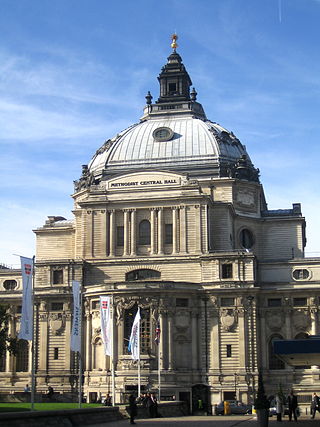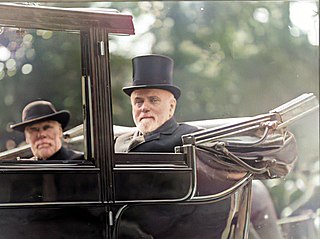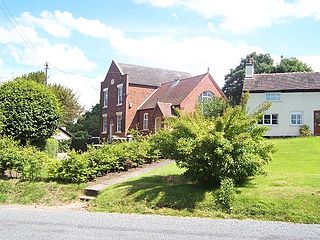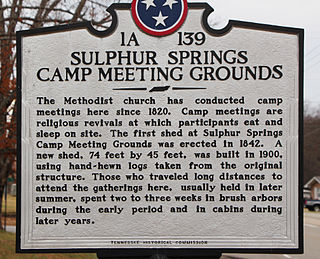
The camp meeting is a form of Protestant Christian religious service originating in England and Scotland as an evangelical event in association with the communion season. It was held for worship, preaching and communion on the American frontier during the Second Great Awakening of the early 19th century. Revivals and camp meetings continued to be held by various denominations, and in some areas of the mid-Atlantic, led to the development of seasonal cottages for meetings.
The Primitive Methodist Church is a Methodist Christian denomination within the holiness movement. It began in England in the early 19th century, with the influence of American evangelist Lorenzo Dow (1777–1834).

Primitive Methodism was a major movement in English and Welsh Methodism from about 1810 until the Methodist Union in 1932. It emerged from a revival at Mow Cop in Staffordshire. Primitive meant "simple" or "relating to an original stage"; the Primitive Methodists saw themselves as practising a purer form of Christianity, closer to the earliest Methodists. Although the denomination did not bear the name "Wesleyan", Primitive Methodism was Wesleyan in theology, in contrast to the Calvinistic Methodists.

Hugh Bourne along with William Clowes was the joint founder of Primitive Methodism, the largest offshoot of Wesleyan Methodism and, in the mid nineteenth century, an influential Protestant Christian movement in its own right.
William Clowes (1780–1851) was one of the founders of Primitive Methodism.
Arthur Samuel Peake (1865–1929) was an English biblical scholar, born at Leek, Staffordshire, and educated at St John's College, Oxford. He was the first holder of the Rylands Chair of Biblical Criticism and Exegesis in the University of Manchester, from its establishment as an independent institution in 1904. He was thus the first non-Anglican to become a professor of divinity in an English university.
The tiny hamlet of Ramsor in North Staffordshire played a significant part in the origins of Primitive Methodism. Listed in the Domesday Book as Ramshorn, this ancient hamlet is a typical example of the depopulation of the countryside. Very little now remains of this village apart from a few farms and cottages. The Primitive Methodist Chapel is the only surviving public building.

Methodist Union was the joining together of several of the larger British Methodist denominations. These were the Wesleyan Methodists, the Primitive Methodists, and the United Methodists. The process involved many years of negotiation and discussion, as well as a vote by the members of each denomination to approve the union. In 1932 a Uniting Conference met on 20 September in the Royal Albert Hall, London. It adopted the Deed of Union as setting forth the basis of union and declaring and defining the constitution and doctrinal standards of the Methodist Church, and a new Model Deed was executed.

The organisation of the Methodist Church of Great Britain is based on the principle of connexionalism. This means that British Methodism, from its inception under John Wesley (1703–1791), has always laid strong emphasis on mutual support, in terms of ministry, mission and finance, of one local congregation for another. No singular church community has ever been seen in isolation either from its immediately neighbouring church communities or from the centralised national organisation. Wesley himself journeyed around the country, preaching and establishing local worshipping communities, called "societies", often under lay leadership. Soon these local communities of worshipping Christians formalised their relationships with neighbouring Methodist communities to create "circuits", and the circuits and societies contained within them, were from the very beginning 'connected' to the centre and Methodism's governing body, the annual Conference. Today, societies are better known as local churches, although the concept of a community of worshipping Christians tied to a particular location, and subdivided into smaller cell groups called "classes", remains essentially based on Wesley's societies.

Rev. Richard Jukes (1804–1867) was a popular Primitive Methodist minister and hymn writer. This article provides a brief biography, and a summary of his work as a popular minister and hymn writer during the first half-century of Primitive Methodism.

Sir William Pickles Hartley was an English jam manufacturer and philanthropist who founded the Hartley's jam company.

Cradley Heath Baptist Church, also known as Four-ways Baptist Church, was the first Church of any denomination to build a chapel in Cradley Heath, West Midlands. The first meeting was in December 1833, in Grainger's Lane. Later, land was bought near the Four-Ways end of the High Street, and a meeting place was built. The site was expanded, and two further buildings were built, the last in 1904.
John Wilks was an English Whig Party politician who sat in the House of Commons from 1830 to 1837.
James Dennis Hird was a British clergyman, educator and author.
The Primitive Methodist Magazine was the monthly magazine of the Primitive Methodist Church in Britain, spanning just over a century. It was started in 1821. From 1821, the Magazine was edited by Hugh Bourne, who printed the magazine at Bemersley Farm about 2 miles from Mow Cop. Production was moved to London in 1843 when John Flesher became the Editor. One of the more famous editors was H B Kendall, the writer of three major histories of Primitive Methodism.

Rev. George Cosens (1805–1881) is the "first reported West Indian minister to hold a pastorate in Britain." He originated from Jamaica, and lived most of his life in Britain having moved to London to study and joining the Primitive Methodists in his late teens. After working as a Primitive Methodist preacher, he joined the Baptists and from 1837 served as a minister in various Baptist churches. He died in working retirement in 1881. George Cosens married twice, Mary Burnet, 1830, and being widowed, Betsy Dancer in 1841. He is buried in the cemetery of Brierley Hill Baptist Church.

Englesea Brook Chapel and Museum is in the village of Englesea-Brook, Cheshire, England. Built in 1828, the chapel was one of the earliest chapels of the Primitive Methodist movement, and the Sunday school was added in 1914. Since 1986 it has been a museum of Primitive Methodism. The building is recorded in the National Heritage List for England as a designated Grade II listed building. In the chapel is a historic pipe organ. The museum contains artefacts relating to the movement, and arranges a changing programme of exhibitions and other events. In the graveyard near the museum is a monument to Hugh Bourne, founder of the movement.

The Wesleyan Church is a former Methodist church for the town of Aldershot in Hampshire, England. Closed in 1988 the building has been a Grade II* listed building since 30 April 1981. In use today as offices, a dental studio and a gymnasium, the former Wesleyan Church is situated on the corner of Grosvenor Road and Queens Road in Aldershot.

A brush arbour revival, also known as brush arbour meeting, is a revival service that takes place under an open-sided shelter called an "arbour", which is "constructed of vertical poles driven into the ground with additional long poles laid across the top as support for a roof of brush, cut branches or hay".















